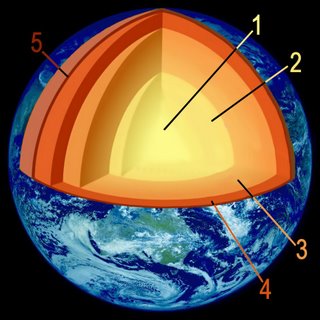Earth's structure
 The Earth has several layers each with its own physical properties (left – higher temperature indicated by lighter color)
The Earth has several layers each with its own physical properties (left – higher temperature indicated by lighter color)1. solid core – high pressures maintain the hot, mostly iron-nickel center in the solid state
2. liquid core – cooler than the solid inner core, but liquid because of lower pressures
3. inner mantle – 1000°- 4,000°C, the asthenosphere, or low velocity zone, is a plastic zone extending from the lithosphere to a depth of 250 km, perhaps as much as 400 km.
4. outer mantle – 500°C-900°C at boundary with crust, the outer mantle is part of the lithosphere that is relatively cool, chemically different than most of the mantle (mafic) and considered more resistant to deformation than the crust, extending from the Mohorovičić discontinuity (moho) to a depth of about 100-250 km
5. crust – the upper lithosphere is relatively light and brittle, composed of less dense felsic rocks, such as granites that have differentiated from melted mantle; typically about 25 miles thick beneath continents, and about 6.5 miles thick beneath oceans. The average thickness of the continental crust is about 35 to 40 km (image below right - click to enlarge), whereas that of oceanic crust is 7-10 km.
 Oceanic crust is younger than tectonic plate boundaries at continental margins.
Oceanic crust is younger than tectonic plate boundaries at continental margins.The oldest oceanic crust dates from about 180 Ma (Jurassic) and lies adjacent to continents, while the youngest crust lies adjacent to the mid-oceanic ridge centers. The farther that oceanic crust lies outward from the mid-oceanic ridges, the older the rocks. The paleomagnetic signature of oceanic crust records geomagnetic reversals parallel to the ridge structures.
Because the continental crust is thrust up over oceanic crust at subduction zones, oceanic crust is consumed while continental crust survives. As a result, the Earth's oldest rocks are to be found within the cratonic cores of continents, and the oldest known continental rocks are Canada's Acasta Gneisses in the Slave Craton (Hadean tonalite gneiss, 4.03 Ga, image). A 4.2 Ga zircon xenocryst has been reported within a 3.9 Ga granitic rock of the Acasta Gneiss Complex [r, r2, im2].
Petrology:
The brittle, cool rocks of the crust belong to either the felsic continental crust or the mafic oceanic crust.
Rocks of the oceanic crust are mafic basaltic rocks (sima) with a mean density of about 3.3 grams per cubic centimeter (more dense than felsic continental rocks). With an average thickness of 10 km, the oceanic crust is thinner than the continental crust [image above right, crustal thickness].
The felsic continental crust average to approximately the composition of granodiorite. By virtue of its relative low density, continental crust is rarely subducted or re-cycled back into the mantle, although the collision of continental tectonic plates does cause the crust to thicken, causing melting of the deepest crustal rocks.
Mantle rock that lies shallower than about 400 km (4) comprises mostly olivine, pyroxenes, spinel, and garnets. Typical rock types are believed to be peridotite, dunite (olivine-rich peridotite), and eclogites. As predicted by laboratory investigations replicating high mantle pressures (diamond anvil), olivine is not stable between about 400 km and 650 km depth (upper 3), and is replaced by high pressure polymorphs with approximately the same composition. Olivine polymorphs include wadsleyite (beta-spinel type) and ringwoodite (gamma-spinel structure). Deeper than about 650 km (3), upper mantle minerals become increasingly unstable, so that the most abundant minerals have orthorhombic (pseudocubic) crystal structures (but not compositions) like that of the mineral, perovskite (CaTiO3). At high pressure conditions in the mantle, the pyroxene enstatite (MgSiO3) is a perovskite polymorph that may be the most common mineral in the Earth. The changes in mineralogy at about 400 and 650 km yield distinctive signatures in seismic records of the Earth's interior, and like the Moho are readily detected using seismic waves.
◙ subduction zone magmas ◙
Labels: asthenosphere, continental crust, core, diamond anvil, dunite, Earth structure, eclogite, garnet, layers, Mohorovičić discontinuity, olivine, peridotite, polymorphs, pyroxenes, spinel






































